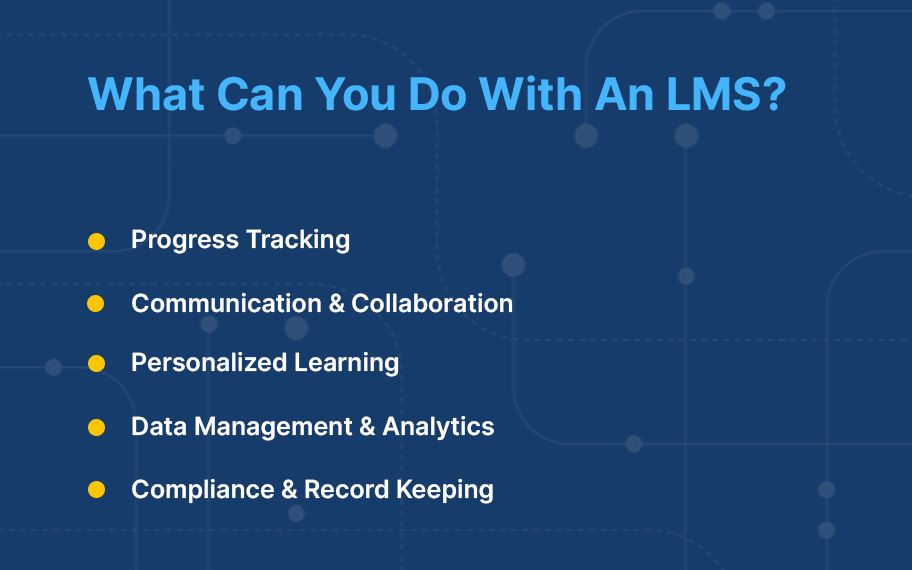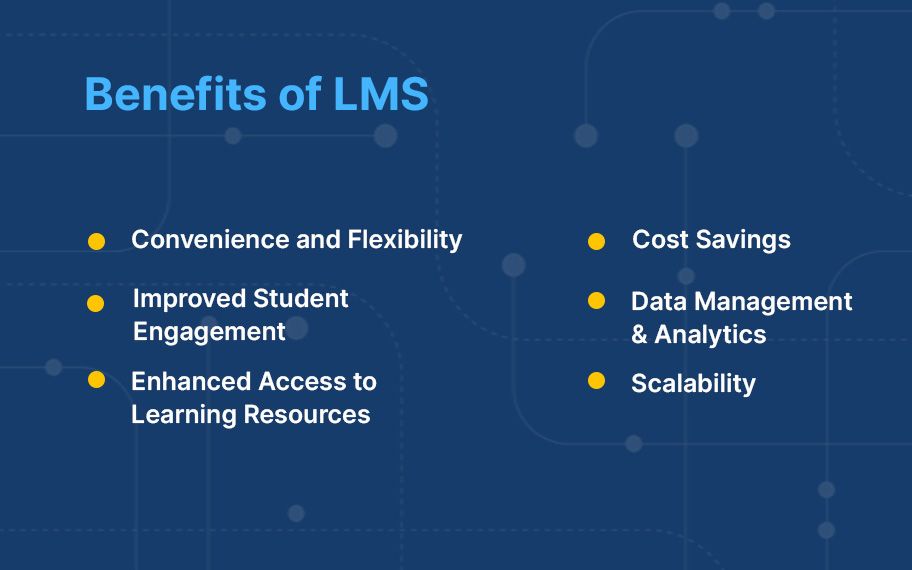The educational landscape has undergone significant changes in recent years due to the increasing adoption of automation and digitization. The rise of technology has made it possible for teachers to deliver instruction and assess student learning in new and innovative ways.
Another change has been the increased use of data and analytics in education. With the help of technology, teachers can track student progress and performance in real-time and make data-driven decisions about instruction. This has led to a more personalized and effective learning experience for students.
Additionally, automation and digitization have also improved the efficiency and effectiveness of administrative tasks such as attendance management, grading and assignment tracking, and even student fee management. All these have reduced the burden on teachers and allowed them to focus more on instruction and student learning.
How Does LMS Work?
A Learning Management System (LMS) is a software solution that enables teachers & students to interact with each other and make the educational process much more interactive and engaging. It is a digital platform that serves as a central hub for all educational materials, including syllabi, assignments, quizzes, and tests. It also allows for communication and collaboration between students and teachers and tracking student progress and performance.

1. Progress Tracking
A school LMS allows teachers to track student progress and performance, including attendance, assignment completion, and test scores. This information can be used to identify areas where students may be struggling and provide additional support if needed.
2. Communication and Collaboration
A school LMS allows for communication and collaboration between teachers and students. Teachmint allows easy communication between students and teachers through the Private Chat feature, allowing them to interact after class to clear doubts and help with school assignments if required. Teachmint also has a dedicated parent portal which allows parents to keep track of their child’s progress and how they perform academically. The parent app also allows them to keep in touch with the teachers and contact them when required.
4. Data Management and Analytics
Teachmint allows the management of student data and provides analytics and reporting tools, thanks to its integration with the school ERP. It enables teachers to identify areas of improvement, identify at-risk students, and evaluate the effectiveness of their teaching methods.
5. Compliance and Record Keeping
Teachmint helps schools meet compliance requirements and keep records of student performance, which can be helpful in accreditation and other evaluations. This is especially true when it comes to Teachmint because of its integrated nature.
6. Personalized Learning
An LMS allows teachers to provide students with a more personalized learning experience. They can track student progress, identify areas where students may struggle, and provide additional support. Teachmint helps students to progress at their own pace rather than being held back by the pace of the class. Teachmint's LMS can also allow students and teachers to access various educational resources, such as e-books, videos, and articles through the Digital Content platform which can help to supplement and enhance their learning experience.
Benefits of LMS
Learning Management Systems (LMS) have become increasingly popular in education due to their many benefits. These include:
1. Convenience and Flexibility
Teachmint allows students to access course materials and complete assignments on their schedule from any location with internet access. This can be particularly beneficial for students who cannot attend traditional classroom-based courses, such as those with busy work schedules or living in remote areas.
2. Cost Savings
A school LMS can save schools money by reducing the need for classroom space, textbooks, and other traditional educational materials.

3. Improved Student Engagement
An LMS allows teachers to incorporate interactive elements, such as quizzes, discussions, and multimedia content, into their courses. This can help keep students engaged and motivated to learn.
4. Enhanced Access to Learning Resources
Teachmint’s School LMS provides students access to various educational resources, such as e-books, videos, and articles. Teachers can easily share their own study materials, and students can share their materials. This can help to supplement and enhance the learning experience.
5. Data Management and Analytics
The school learning management system allows teachers to track student progress, performance, and engagement. It provides analytics and reporting tools that enable teachers to identify areas of improvement, identify at-risk students, and evaluate the effectiveness of their teaching methods.
6. Scalability
Teachmint’s School LMS can handle large numbers of students making it a practical solution for institutions of all sizes, from small schools to large chains of schools.
LMS in Indian Education (NEP 2020)
The National Education Policy (NEP) 2020 aims to reform the education system in India and make it more technology-enabled and accessible.
One of the key objectives of this policy is to create a digital education infrastructure and use technology to improve the quality of teaching and learning. To achieve this, the policy has recommended the use of Learning Management Systems (LMS) in schools.
The NEP recommends that all schools have an LMS to support teaching and learning. It should be used to create and deliver digital curricula, track student progress, and provide communication and collaboration tools for teachers and students.
Additionally, the NEP recommends that the LMS be accessible to students and teachers on mobile devices to support mobile learning. This is important as it allows students and teachers to access learning resources and tools wherever they are. It also mandates that the LMS be integrated with other digital tools and platforms, such as digital libraries, assessment tools, and analytics platforms, to support teaching and learning.
The National Education Policy mandate for LMS in schools is a step towards digitalizing the education system in India, improving the quality of teaching and learning, and making it more accessible and inclusive. It also encourages technology integration in education to make it more learner-centric, effective, and efficient.
Must Have Features of an LMS
It is important to note that the education market has become significantly comparative with every organization ensuring that they stay on top of education Trends and knowledge. At the same time, they are also dedicated towards finding the best course of action that can contribute towards providing better automation and Management during everyday operations.
The Indian education sector is considered to be faced with an immediate need to manage the wide array of tasks that includes maintaining the standard of education within the schools as well as ensuring that the everyday operations are staying up-to-date.
This is exactly the reason why the presence of the learning management system contributes towards helping education institutions to create a smooth order within the schools and colleges.In this given section an assessment will be carried out regarding the major compelling features associated with LMS. it will outline the different ways LMS portals can be used to provide better support to schools.
1. The function of Course Builder
The basic feature of any LMS is the ability to ensure that it can build different courses. This means that any institution can easily develop a professional looking course within a span of minutes and add audio, multimedia files and even video to give it a strong Outlook. it should even have the function of uploading materials and resources required for training across different formats like PDF or Word documents.
It should also have options for managing branding needs such as including the logo of the Institution, managing colors schemes and so on. it should also have the option of organizing the content topic wise and chapters making it easier for the students to understand. These are basic features that should be present across every LMS software and as a result Institutions should check whether this function is available before implementing.
2. Management functions
An important feature of LMS software is that it allows the administration to organize learners into several groups under a set of criterias. This can be based on the type of training being provided to the students, their classes, subjects, etc.
As a result, this will ensure that the education institute can easily assign courses to different groups and also select group admin who will be responsible for managing these groups on an everyday basis. The learners can make use of the LMS portals to communicate easily. This will also contribute towards saving time and effort as LMS can enable the function of self registration for the learner.
Another major factor that stresses the need for having an LMS is that it can help Institutions invite course participants in bulk and send notifications for the same easily.
3. Managing Regular Assessments
Another must-have feature of an element is its ability to conduct regular assessments. It is a requisite of the teachers to test the knowledge retention of the students on a weekly or monthly basis which can be easily achieved by the implementation of the software.
The teachers can develop online quizzes and provide them to the students to test their knowledge easily using this software. The major benefit associated with this process is that the teacher can take multiple assignments of a large number of people at the same time without any hassle.
Similarly, once the test has been completed the teacher can also use this system to check the answers provided by the student and thereafter provide the students with the requisite grade. Using this method it becomes easier for the Teachers to test the knowledge retention by the students and also make the learning process exciting by using mode of quizzes in the software.
4. Tracking Progress in Real-Time
Artificial intelligence is slowly getting recognised and utilized by several sectors across the industry considering the automation and reduced errors it provides. One of the must-have features of this software is its ability to be able to track progress and develop analytics in real time.
The software utilizes AI Technology that helps in auto-generating reports and statistics, and provides clear insights about the current progress being made by the students through graphic visualization. It can take into consideration the several parameters of the students including their performance, previous and existing milestones, the challenges they may have faced in class and their current progress.
Based on these features it becomes easier for the Teachers to develop consolidated reports both for the individual students as well as for the entire class. Through this report the teacher is provided with a “bird-eye” view of the progress being made within the classroom. Another important feature that is present is that the LMS reporting function allows the teacher with access to the actionable data easily.
5. The facility of mobile learning
During and after the pandemic one of the most significant changes that has been observed across the world is an increase in the use of Smartphones. Most students were able to continue with their education process in the Indian market because of the presence of smartphones that allowed them to have access to education resources.
An important and essential feature of the LMS software is that it has the ability to provide access to its uses to training materials and assessment through the use of portable devices such as tablets and Smartphones. This encourages the students to be able to complete their assignments on time and also contribute towards better retention of knowledge.
This is considered to be an essential feature because it has a “self-paced” micro learning function present that can be easily loaded on personal devices. This is extremely helpful for those students who are working and studying at the same time. This helps them manage their hectic schedule and provides them the flexibility to study at their own pace.
Based on all these functions it can be stated that there is an added advantage for Institutions who implement the Learning Management System software. This is because it not only enables them to have better control over managing everyday administrative tasks but also helps in the development of a strong and functional learning environment.
Why Teachmint
Teachmint is an Integrated School platform that has been designed to meet the requirements of the National Education Policy 2020 in India. The platform is already NEP compliant and can be used by schools to manage their operations and deliver education. Teachmint comprises a school LMS, a school ERP for digitizing and automating the process of school management, and a digital content platform. School management software consists of several assistive/completely automated software solutions such as fee management software, admission management system, transport management system, inventory management, and several other features. Visit Teachmint and learn more about our offerings!
Learn more about Teachmint plans here.






